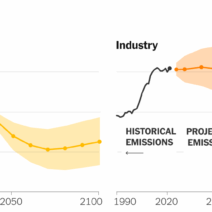The mechanisms through which power stations impact global warming are complex and multifaceted. At its essence, energy production is intricately linked to the emission of greenhouse gases, which are significant contributors to the climate crisis. As we delve into this pressing issue, one might ponder: If power stations were to vanish overnight, would our world feel a sense of peace or chaos?
Power stations are primarily responsible for the generation of electricity, which is a vital component of modern civilization. However, the predominant type of power generation worldwide still relies heavily on fossil fuels—coal, oil, and natural gas. These energy sources release carbon dioxide (CO2) and other pollutants when combusted. The combustion process is not merely a mechanism of electricity generation; it initiates a far-reaching chain reaction within the atmosphere.
The elemental contribution of power stations to global warming can be understood through their emissions profile. According to the United Nations, the energy sector is responsible for over 70% of global greenhouse gas emissions. The burning of coal, in particular, emits the highest amount of CO2 per unit of energy produced. This generates both short-term and long-term environmental consequences, as excess CO2 in the atmosphere traps heat and leads to rising global temperatures.
In this context, let’s explore how these power stations affect our planet. When a coal power station operates, it does more than just produce electricity; it releases a multitude of emissions, including sulfur dioxide (SO2), nitrogen oxides (NOx), and particulate matter. These substances contribute not only to climate change but also to air quality deterioration that promulgates severe health risks for communities situated near these facilities.
Once in the atmosphere, CO2 has a long residence time, which means it can remain for centuries, continuously affecting the global temperature. This long-term impact is exacerbated by the sheer volume of energy consumed globally. With an ever-increasing population and heightened energy demands, the precarious reliance on fossil fuel power stations creates a compounding effect on climate change. Moreover, it is pivotal to consider that alternative energy sources are often regarded as insufficient to meet current energy demands, posing the challenge of balancing consumption and sustainability.
The statistical reality is alarming: In 2020, coal-fired power stations generated approximately 57% of the electricity in countries like China, which ranks as the largest CO2 emitter globally. This dependency creates a climate paradox. The immediate availability and low cost of fossil fuels bolster their continued use, while the long-term environmental ramifications catalyze climate change—a paradigm that needs rethinking.
Beyond just numbers, we can observe the tangible impacts of power stations on our ecosystems. For instance, thermal pollution results from the discharge of heated water used in cooling systems back into bodies of water. This change in temperature can disrupt aquatic ecosystems, trigger algae blooms, and adversely affect biodiversity. Additionally, the extraction of fossil fuels entails significant ecological disruption, leading to habitat destruction and increased carbon emissions before the fuel even reaches the power station.
The stark reality of energy production begs the question: Can we imagine a world where our power stations contribute positively rather than negatively? Transitioning towards renewable energy sources like solar, wind, and hydroelectric power presents a viable pathway. These alternatives are becoming increasingly viable as technology advances, leading to decreased costs and enhanced energy efficiency. Nevertheless, the challenge remains—transitioning an entire industry and the workforce that supports it requires not only innovation but also radical policy changes and public commitment.
One of the major obstacles in this transition is energy storage, especially with renewables that are subject to variability based on weather conditions. Innovations in battery technology and grid management systems are essential to ensure reliability and quality of energy supply. In embracing change, society might pose an important question: What role do we want energy to play in our lives? Should we retain fossil fuel power stations that hinder global efforts or ally with renewables that promote sustainable growth?
The future of energy production and its impact on global warming depends on a collective approach that encompasses technology, policy, and social acceptance. The pathway to sustainable energy is laden with challenges, yet it also brims with opportunities for innovation and economic growth. Governments and communities must work in tandem to implement policies that promote renewable infrastructure, foster research and development, and incentivize the workforce transition.
Ultimately, the role of power stations in exacerbating climate change cannot be overstated. However, it is crucial to acknowledge that they also hold the potential to be transformed into instruments of change. By minimizing reliance on fossil fuels and maximizing the use of renewable energy, we take essential strides towards combating the climate crisis. The transition may be arduous, but it is necessary for a sustainable future.
In conclusion, as we grapple with the ramifications of energy production on our planet, introspection is vital. Let us ask ourselves how energy could be harnessed more responsibly. It is a challenge that requires not only scientific ingenuity but collective action to foster an environment where energy generation aids rather than hinders our planet’s health. Only through such introspection and action can we hope to mitigate the effects of global warming and safeguard the world for future generations.







